42-year-old French man Jean-Sébastien Grill has spent more than seven years learning and practicing Vietnamese calligraphy. And his hard work has paid off. Jean was invited to do calligraphy at the Temple of Literature, Vietnam’s first university, during the 2023 Lunar New Year Festival.
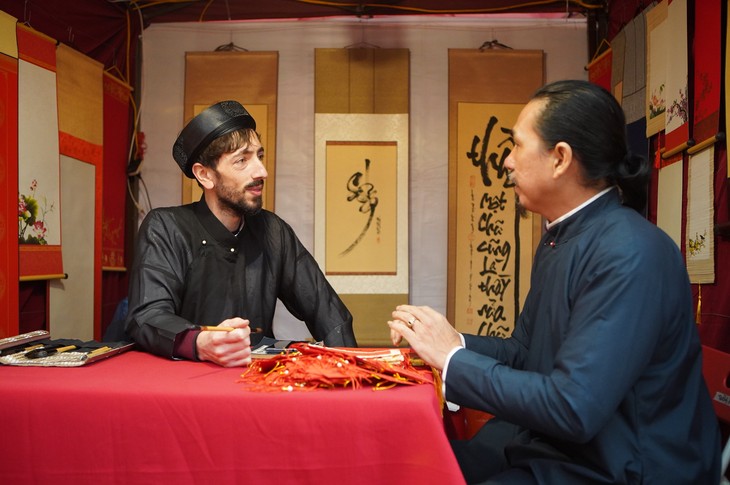
French calligrapher Jean-Sébastien Grill talks with a visitor at the Temple of Literature during the 2023 Lunar New Year Festival. (Photo: Ngoc Mai/VOV5)
“Maybe in my previous life I was Vietnamese.” That’s how Jean, who also goes by his Vietnamese name Truong Giang, expresses his intense love for Vietnamese people and culture.
He said “Giang” is pronounced like “Jean” and “Truong Giang” suggested the meaning of “long life.”
Jean stood out among the 50 calligraphers sitting at the Temple of Literature in Hanoi. Dressed in the traditional attire of a feudal scholar, a long dress and turban, he completed his Lunar New Year calligraphy “Xuan Phat Tai” (Prosperous Spring) and gave it to visitors. He described his passion for Vietnamese calligraphy as “predestination.”
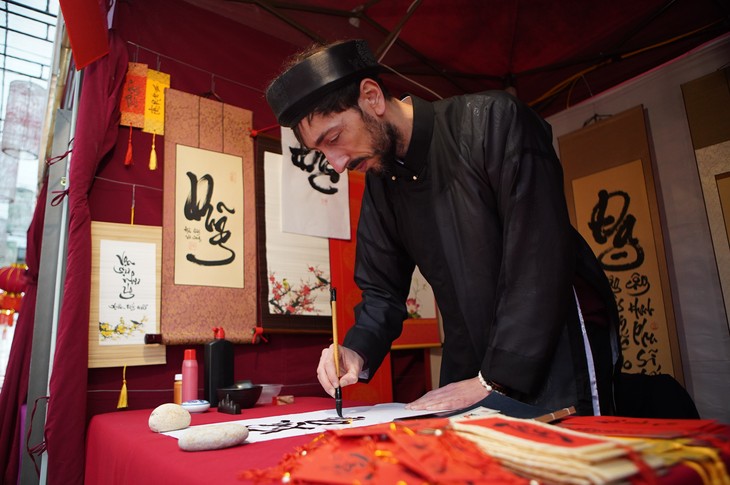
Jean describes his passion for Vietnamese calligraphy as “predestination.” (Photo: Ngoc Mai/VOV5)
"I think it is a predestination between me and the Vietnamese culture, as I have learnt Vietnamese calligraphy and been obsessed with it for seven years. That's why I consider Vietnam my second homeland and chose to pursue calligraphy in Vietnam instead of another country," said Jean
"Vietnam and its people have a very special spirit and energy that have inspired me and nurtured my passion for this art. When writing Vietnamese calligraphy, I feel like I am connected with the Vietnamese spirit, culture, and people, imbued with national identity," he added.
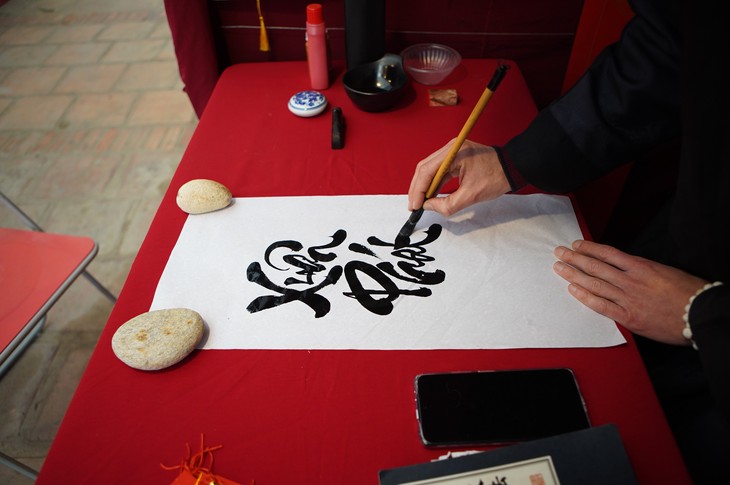
Jean's calligraphy "Xuan Phat Tai" (Prosperous Spring). (Photo: Ngoc Mai/VOV5)
Calligraphy (“thu phap” in Vietnamese), is the traditional art of writing. “Thư” means script, and “pháp” means rule, so “Thu phap” literally means the rule of writing. Calligraphic works use a variety of scripts, including Chinese characters, and Sino-Vietnamese characters (chu Nom), and the Latin-based Vietnamese alphabet.
The characters drawn by calligraphers are symbols of good luck used in worshipping practices for thousands of years in Vietnam. Calligraphy has a special place among the customs of Tet, the Lunar New Year festival. People come to scholars and tell them about their wish for the New Year, which is then will be written on Poonah paper. Many believe the calligraphic script will help turn their wish into reality.
Jean is proud of being given the opportunity to do calligraphy at the Temple of Literature this year, after finishing in second place in the 2023 Spring Calligraphy Writing Competition.
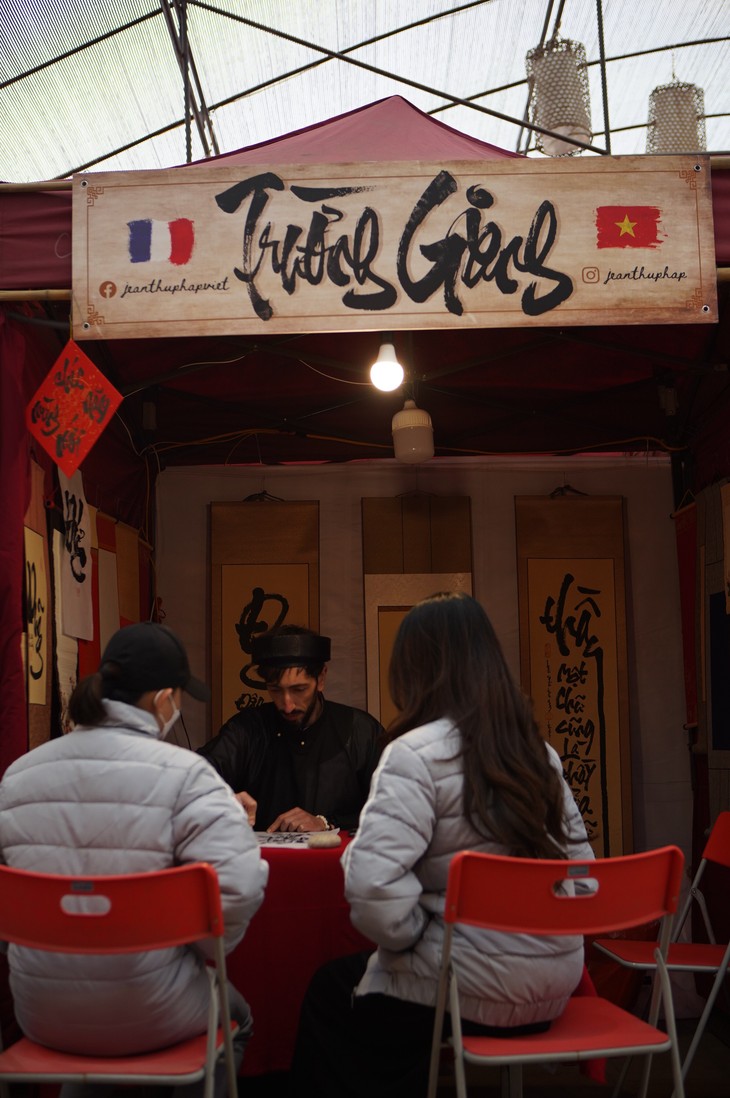
Jean is given the opportunity to do calligraphy at the Temple of Literature during the 2023 Lunar New Year Festival. (Photo: Ngoc Mai/VOV5)
"I was the only foreigner chosen to participate in the calligraphy festival at the Temple of Literature. I didn’t want to go there to be different or stand out, but to highly respect and integrate into the Vietnamese culture as well as contribute to promoting the Vietnamese culture among European tourists," he said.
"I’m very proud that I had a chance to participate in such a huge event for calligraphers. I followed the tradition of wearing the long dress and turban and sat down to produce calligraphies for visitors like the Vietnamese scholars."
In France, Jean was a graphic designer. This prepared him to practice Vietnamese calligraphy. But it was hard at first.
"The most challenging part was that I didn’t know how to control the brush properly. Though I’m more proficient now, I still want to improve my skill, so I spend lots of time learning Sino-Vietnamese parallel sentences," he said.

Jean writes calligraphies for visitors. (Photo: Ngoc Mai/VOV5)
Vietnamese calligraphy is a visual art that reflects the writer’s style, education level, personality, and ideology, Jean said. While developing his calligraphic skill and figuring out his own style, he has learned many things to improve himself.
"In addition to calligraphy, I also studied Vietnamese traditional medicine and Tai Chi Chuan. I believe they are related to each other, and they have helped me to practice calmness, carefulness, and concentration. Using traditional medicine, I give people free medical examinations, and using calligraphy, I transfer good wishes and positive energy to people."
"I think that with each character drawn, the scholar should express 3 things: the beauty of the strokes, the meaning of the character, and the power and charisma of the writer. Thanks to calligraphy, a scholar, by writing meaningful characters, can transmit spiritual value and bringing people’s wishes to reality," Jean said.
For Jean, Vietnamese calligraphy is more than just an art, it has nurtured his soul and enriched his spiritual life. It has inspired him to promote this traditional skill to his foreign friends in various ways.
Jean said he is planning to open a class to teach Vietnamese calligraphy and a calligraphy exhibition to showcase his works in order to indulge his passion, and promote the meaningful beauty of Vietnamese culture to the international community in France.
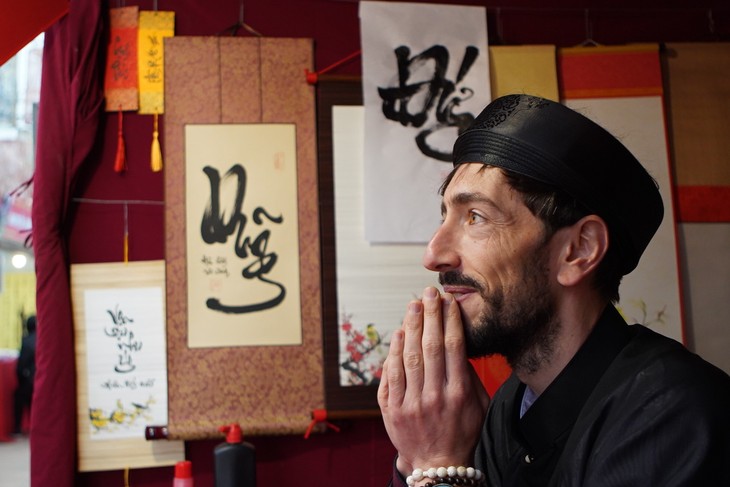
For Jean, Vietnamese calligraphy is more than just an art, it has nurtured his soul and enriched his spiritual life. (Photo: Ngoc Mai/VOV5)
No matter what challenges he faces, Jean never gives up. He has never stopped spending nights and weekends alone in his study honing his Vietnamese vocabulary, grinding his ink, and practicing calligraphy. His persistent efforts have wowed both Vietnamese and foreigners.
Here are what visitors, who received calligraphy works from Jean, have to say about him.
“It was amazing that a French calligrapher gave me this beautiful calligraphy. I love it! Very impressive!”
“He gave me the word 'Duc' in Vietnamese, which he explained to me means 'Moral'. Just looking at the text, I would never imagine this Vietnamese calligraphy was written by a foreigner."
“Every year I go to the Temple of Literature to ask for a New Year calligraphy. This is the first time I’ve seen a foreign calligrapher here. It made me curious, so I asked for the word 'Tai' (Talent), as this year I’m going to take the university entrance exam. The calligraphy is very beautiful!”
Ngoc Mai